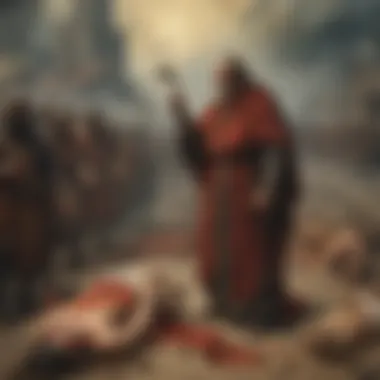The Ten Plagues: An In-Depth Cultural Analysis


Intro
The topic of the Ten Plagues provides a fascinating glimpse into historical events and their repercussions on societies over millennia. These plagues, primarily narrated in religious texts, unveil multifaceted themes such as power manifestations, justice served or withheld, and human resilience in the face of grim adversity. This analysis not only sheds light upon the circumstances surrounding the ancient occurrences, but also articulates significant reflections in contemporary discussions regarding human morality and societal values.
These plagues challenge readers to ponder ethical questions and motivations that drive individuals and groups into actions seen in both historical and modern contexts. Understanding their implications requires thoughtful exploration, urging us to consider how perceptions of justice and power evolve. Here, we examine the individual plagues and their broader sociocultural significances, offering insights into civilizations long past and a more profound consciousness of the human condition.
Historical Context of the Plagues
The Ten Plagues are rooted in the narrative of ancient Egypt, illustrating a clear conflict between the Israelites and the ruling Pharaoh. The study of these plagues transcends mere storytelling; it invokes insights about dynastic struggles, cultural memory, and explosions of supernatural belief. Consider the origins of these events intricately plotted, casting light on historical realities shaped by ideology, fear, and prophecy.
Different cultures interpret these occurrences variably, demonstrating how myth-making and history intertwine. Calendars and rituals mirrored theologies that framed suffering and salvation in ways still evident today.
Cultural Reflections
Understanding these historical developmentsʔ we gain insights into enduring moral conflicts. The narratives surrounding the Ten Plagues often raise inquiries about divine justice and human agency. Historians and theologians alike analyze these questions as they apply both ancient narratives to modern contexts.
For many cultures, the consequences of these plagues resonate on moral terrain—shedding light on our responsibilities as societal actors. The rich commentary growing from this enduring subject explicates how societal structures adapt and react to shared suffering, societal power-play patterns, and the interpretive bends based on core ethics. The dialogues reveal shifts in priorities over time, enriching philosophical inquiry.
Overall, engaging realistically with the Ten Plagues fosters deeper understanding of historical calamities as conduits for moral discourse in society, prompting exploratory questions that remain topical. A thorough analytical overview compartmentalizes elements forming humanity's evolving consciousness on justice, power dynamics, and triumph over adversity.
Preamble to the Ten Plagues
The Ten Plagues of Egypt are significant events described in the religious texts, particularly within the Book of Exodus. They provide a vital framework for understanding the complex dynamics of power, faith, and socio-political conflicts in ancient society. This section emphasizes their historical and religious importance and sets the stage for analysis that follows in this article. Understanding these plagues also leads to valuable discussions about justice and resilience in human history.
Historical Context
The backdrop to the Ten Plagues draws heavily from historical and archaeological research around ancient Egypt. Scholars place the story within a time likely aligned to a period of strife in Egyptian history. Surrounding calamities, shifts in governance, and external threats painted a vivid picture. The narrative focuses on Moses and his divine mission to free the Israelites from slavery, highlighting the crises exemptions that made pharaonic power seemingly vulnerable. These elements remind us that amid divine interventions, ancient leaders struggled with maintaining authority and control. The distinctive nature of the narrative amplifies the discussion surrounding oppression, power, and retribution against authority figures who ignore messages or failed to heed warnings.
The importance of examining the historical context lies in recognizing tangible events Ethat could correlate with the plagues. Many theories suggest that natural disasters impacted society. This examination questions whether these events were miraculous occurrences or the aftermath of social conditions and reaction within the societal narrative. By placing the plagues in context, readers better understand not only their occurrence but also their effects on social structures of that time.
Religious Significance
The religious dimension of the Ten Plagues provides tools for moral and philosophical discussion. Each of the plagues serves not merely as a demonstration of divine power but as a narrative vehicle through which lessons on faith, repentance, and moral ethics emerge. Followers of the eternal covenant debate their meaning, purpose, and implications. This exemplary function is built into many religious discourses.
Furthermore, the frequency of these events in various religious practices suggests a collective memory that conveys lessons regarding defiance against divine authority. Many religious teachers utilize these stories to illustrate concepts of divine justice, compassion versus vengeance, and the call for ethical living in alignment with spiritual principles.
Understanding these religious implications opens doors for cross-cultural reflections on similar historical accounts. The prominence of divine warnings and retributions resonates through many cultures' belief systems, suggesting a shared human experience through trials and suffering.
Thus, the exploration of the Ten Plagues extends beyond literature and religion into a broader conversation about justice and ethics that remains relevant in today’s world.
By bridging these themes, the importance of the plagues' context integrates histories that enrich our understanding of ancient affiliations between human behavior, authority, and divine observation.
The Nature of Plagues
Understanding the nature of plagues is crucial when exploring the Ten Plagues described in ancient texts. Each plague not only represents a moment of calamity but further serves as a lens through which we can investigate the broader themes of authority, fate, and morality. An in-depth comprehension of this topic enriches our analytical capabilities, connecting ancient events to modern discussions in ethics and human behavior.
Definition of Plagues
The term "plague" frequently conjures images of widespread catastrophic events, often wrought by nature or divine intervention. In the context of the Ten Plagues in the Book of Exodus, a plague may be defined as a severe affliction or disaster impacting a large region, typically characterized by significant suffering or upheaval. According to various sources, such as Britannica, it can include various forms of pestilence, destructive weather phenomena, or any grave misfortune attributed to higher powers.


Plagues often reflect the greater societal maladies manifested in forms that can threaten both life and civilization itself. The term holds different meanings and cultural weight depending on context, yet each instance marks a universal return to vulnerability, showcasing how humanity grapples with forces seemingly beyond their control.
Possible Explanations
Scholars and thinkers have put forth multiple explanations regarding the presence of the Ten Plagues and their corresponding meanings. The interpretations often fall into various categories:
- Naturalistic Explanations: These perspectives propose that the plagues emanated from natural causes, such as environmental changes or ecological disruptions during that era. For instance, connections to natural phenomena like droughts or disease outbreaks may imply the Egyptians faced unprecedented challenges which manifested as punishment or calamity.
- Divine Interventions: Many religious interpretations focus on the narrative of divine retribution directed at Pharaoh and his people for their enslavement of the Israelites. Each plague in this context signifies a confrontation between mortal authority and divine sovereignty, emphasizing the moral order of the universe as revealed in religious texts.
- Psychosocial Interpretations: Such explanations suggest that the plagues served more than just as events or punishments. Instead, they also highlighted the psychological components—inducing fear, offering warnings, or forcing personal and collective introspection among the ancient populations.
- Political Theories: Some analyses frame the plagues as symbols in political power strife. The struggles depicted could represent the social upheavals whether within the Egyptian populace against their rulers or among different ethno-political groups attempting to assert greater powers.
Ultimately, the exploration of why these plagues occurred entwines a tapestry of infectious curiosity and profound inquiry. Current discussions strive to link ancient experiences to modern reflections of justice and disproportionately experienced suffering among societies.
Ricahrd White, a historian suggests that understanding the both natural and supernatural narratives helps us bridge lived experiences of humanity throughout history.
List of the Ten Plagues
The narrative of the Ten Plagues serves as a vital thematic conduit in understanding ancient texts. Each plague not only demonstrates the immense power attributed to divine forces but also highlights aspects of human resilience, authority, and the socio-political fabric of that era.
Blood
The first plague described in the texts presents a transformation of the Nile's waters into blood. This event symbolizes a direct challenge to the Egyptians and their deities, primarily those of fertility and water. The Nile served as a lifeline for the ancient civilization, underpinning its agriculture and daily life. With the water turned to blood, the very essence of Egypt's existence is called into question.
Frogs
The second plague introduces an invasion of frogs, overwhelming the regions inhabited by the Egyptians. This sudden overabundance disrupts daily routines, showcasing how nature can oscillate between benefactor and adversary. Frogs, often seen as a symbol of renewal, turn into an uncontrollable nuisance. The discomfort led to a dilution of authority as rulers struggled to alleviate the common people's suffering.
Gnats
Gnats arrive following the swarms of frogs, amplifying the discomfort. This plague raises questions about control over the natural world. Experts in Egypt could not provide explanations for this irritation, revealing the frailty underlying their expertise.
Flies
The fourth plague introduces flies, further escalating the oppressive atmosphere. The relentless buzzing serves as a reminder of discomfort and chaos engulfing the land. The presence of flies symbolizes disorder, a significant shift in the societal structure, and deep fluctuations of power roles among people.
Livestock Disease
This plague targets the livestock, striking at the heart of the economy. Economic implications here highlight suffering and distress within the community. Livestock was a primary resource. In a time of agricultural reliance, signal loss reverberates through families and society questioning reliance altar itself.
Boils
The afflicted bodies transporting oozing boils not only reveals suffering but also symbolizes a fracture throughout societal bonds. Social hierarchies dissolve, as the rich find no refuge from pain, equalizing people under suffering. It underscores physical vulnerability bound to the desire for power.
Hail
The documented hailstorm signifies relentless environmental force. Fields, key to sustenance, lay in waste as these destructive piles not only flatline crops but deter people's aspirations. The session evokes imagery of lost hopes and instills a mourning sentiment profoundly riveting societal ties.
Locusts
The transformation of the locusts decimates any notion of controls leftover. As they consume everything in their path, visibility of utopia fades. Food has become scarce; this aggression from nature evokes thematic reflections on vulnerability and fragility in a community’s resilience.
Darkness


As the sun is obscured, an existential ambiguity engulf the Egyptians. It plunges them into despair and chaos, signaling internal discord as the tangible world dims violently. No longer can routine persist, invoking metaphysical questions regarding light — both literally as well as symbolically
Death of the Firstborn
Concluding the plagues, the death of the firstborn reverberates foundational scars amid families. Such a horrific vision positions the senior authorities stripped of protective evaluation. This event grieves not merely physicalhood, also igniting pivotal question around readership and protections upheld against injustices manifesting for habitual society.
The Ten Plagues serve as powerful metaphors, encapsulating themes of authority, liberation, and the barrage of uncontrollable circumstances.
By dissecting the list of plagues, one grasps knowledge regarding its echo throughout history, its lessons still vital in contemporary discussions about governance and human condition.
Implications of the Ten Plagues
The implications of the Ten Plagues are far-reaching. They extend beyond their immediate historical context, touching on moral, ethical, and sociopolitical themes. Throughout the narrative of the plagues, we see a struggle for power between two worlds; the world of the Israelites and the ruling Egyptians. These events opened up critical discussions in areas including leadership, justice, and cultural reflections.
Impact on Ancient Egypt
The Ten Plagues had a momentous effect on ancient Egypt. They destabilized the socioeconomic structure and exposed vulnerabilities present within their civilization. Purportedly, the plagues led to a noticeable decline in agricultural output, economic crises, and social unrest. Those who governed may have been viewed as weak or ineffective, as they could not protect their populace from divine wrath.
- The phenomenon began by disrupting the Nile River, which was central to Egypt's economic lifeblood. Without its water, trade weakened.
- Livestock disease led to food scarcity, enhancing the plight of the people.
- Continuing outbreaks illustrated ineffectiveness in leadership; Pharaoh’s inability to control these events tarnished his image in a belief-driven state.
Such consequences had implications for the future governance of Egypt, shifting how leaders managed their power and religious interpretations.
Lessons in Leadership
From the narrative of the plagues, important lessons in leadership emerge. The Pharaoh's defiance serves as a cautionary tale about leadership buoyed by pride and obstinacy.1737 Looking at his repeated refusals to heed warnings shows a neglect of responsibililty. Such a fatal posture undermines both authority and stability, leading to dire implications.
- Responsive Leadership: Recognizing when one's policies need alteration.
- Ethical Considerations: Valuing the welfare of others over one's interests.
- Awareness of Accountability: Attending to the voices of the people for credibility.
The contrast between Moses's leadership style and that of Pharaoh depicts two worlds. One as just and responsible, and the other oppressive and entrenched.
Themes of Justice and Retribution
The Ten Plagues embody notable themes of justice and retribution. Egypt is seen as a monumental sinner, accused of perpetuating slavery and subjecting the Israelite people to harsh conditions. Each plague reinforces the narrative of divine justice as a form of retribution for transgressions.
- Justice is central to understanding why the plagues are significant. It emphasizes the concept that wrongdoing does not go unchallenged. The oppressed would ultimately see reform.
- Retribution is equally important. The plagues acted as a mechanism to balance moral wrong with consequence, framing a vision that power without justice is unsustainable.
The Cambridge Dictionary defines justice as
Cultural Interpretations
Cultural interpretations of the Ten Plagues enrich our understanding of this significant historical event. They provide insights into how different groups of people understand and contextualize the plagues within their belief systems and social structures. These interpretations can lead to a greater reverence for the text and reveal diverse ethical and moral frameworks. Analyzing these perspectives helps us realize the multifaceted impacts of the plagues across cultures, emphasizing themes of power, justice, and morality.
Jewish Perspective
The Jewish perspective on the Ten Plagues is pivotal in understanding their overarching significance. In Judaism, these plagues exemplify divine intervention in human affairs. They represent both the suffering of the Egyptians as well as the liberation of the Israelites. The Exodus is a core narrative; it depicts not only the struggle between the Israelites and Pharaoh but also the recognition of God's power. Each plague serves a specific purpose, showcasing God's might and leading up to the ultimate liberation of the Israelites.
This significance is often commemorated in the festival of Passover. The Seder meal includes the recounting of these events. It serves both as a remembrance and as a pedagogical tool; the story of the plagues is a lesson on faith, resilience, and community identity.
Christian Perspectives


In Christianity, the Ten Plagues provide rich symbolic meanings. These plagues illustrate God's judgment against the oppressive regime of Egypt. They reveal God's sovereignty and offer thematic representations of salvation and redemption. Different branches of Christianity interpret the plagues in varying ways. Some see them as precursors foreshadowing New Testament teachings. The theme of sacrifice is particularly relevant, reflected in the final plague, the death of the firstborn, leading to the concept of Jesus' sacrifice.
Moreover, Christians may examine the plagues for lessons on repentance, vigilance against oppression, and faith in God's plans. This encourages interfaith dialogue as these interpretations often intersect with discussions of justice and mercy in contemporary society.
Other Cultural Reflections
There are numerous cultural reflections on the Ten Plagues globally. Many indigenous cultures have their stories of natural disasters and divine wrath perceived through their unique cultural lenses.
For example:
- In the African diasporic traditions, the plagues may symbolize the struggles against colonial powers.
- In various Asian contexts, the concept of natural calamities and suffering is intertwined with themes of human morality.
The universality of suffering as depicted in the Ten Plagues allows for the integration of these stories into wider discussions on ethics and morality against oppressive forces. Through these interpretations, we can glean modern messages and apply ancient lessons to current dilemmas in governance, society, and spirituality.
“Understanding cultural interpretations of the Ten Plagues sheds light on the timeless values inherent in humanity's struggle for justice and moral integrity.”
Modern Relevance of the Plagues
The Ten Plagues, while rooted in ancient history, continue to resonate in modern society. These events provide a lens through which we can examine contemporary issues surrounding morality, authority, and human perseverance. By reflecting on the plagues, we can unlock lessons that are key to understanding our own time's trials and tribulations.
Comparative Historical Events
Throughout history, societies have faced challenges resembling the catastrophes described as the Ten Plagues. For example, the Black Death in the 14th century devastated Europe. Much like the plagues, it led to massive loss of life and economic disruption, stirring questions about divine judgment and human morality. Similarly, the cholera outbreaks in the 19th century showed the interconnectedness of public health and social policies, impacting political actions in ways analogous to the acclaim denial by Pharaoh during the plagues.
- Natural Disasters: Floods, earthquakes, and pestilence often invoke similar outcomes as the plagues, influencing leadership and social dynamics.
- Health Crises: The COVID-19 pandemic links directly to modern interpretations of resilience akin to those during the plagues, drawing attention to humanity's response to calamity.
- Political Upheaval: Events like the Arab Spring or economic depressions reflect the thematic struggles seen in Plague narratives—orders crumbling under pressure, just like Pharaoh's defiance facing retribution.
These historical contexts encourage deeper analysis and encourage both scholars and laypeople to consider the responses of societies to overwhelming burdens placed upon them.
Ethical Discussions in the Contemporary Context
The ethical frameworks derived from examining the Ten Plagues impart profound insights for current societal debates. As different cultures interpret the meaning of these events, the notions of justice, suffering, and redemption emerge prominently. Discussions frequently branch into areas like the responsibility of leaders, ethical dealings in crises, and the very essence of justice.
Addressing these three areas provides a comprehensive view for further discussions on ethics today:
- Accountability of Leaders: How should those in power respond during crises?
- Human Rights Implications: What responsibilities do governments hold regarding their people’s wellbeing during disasters?
- The Role of Community: How communities rally or fail to act in times of need fundamentally shapes ethical considerations.
Understanding the stories behind the plagues pushes society's engagement towards responsibility and empathy.
In all analysis of human action, we find threads connecting past and present. The Ten Plagues remind us of the importance of leadership, justice, and compassion in times of upheaval.
To conclude, addressing the significance of these ancient narratives provides largement-enriching paths for ethical discussions today. Just as the plagues challenged humankind of old, our current challenges invite us to explore the deeper meaning of our collective existence and duties toward each other.
End
The conclusion of this article raises crucial points regarding the impact and significance of the Ten Plagues. Analyzing these historical events helps us reflect not only on the past but also on their continuing effects in modern society. It highlights the intersection of morality, power, and justice—core themes that resonate throughout human history.
Reflection on the Plagues' Meaning
The Ten Plagues symbolize more than mere natural disasters inflicted upon ancient Egypt. They portray a profound narrative of resistance and moral obligation. Each plague can be viewed as a response to the oppression faced by the Hebrew people. Their meanings can suggest that oppression leads to inevitable consequences. Understanding the plagues allows us to grasp the complexity of faith, suffering, and divine retribution.
Moreover, reflecting on this narrative offers valuable lessons about resilience in the face of injustice. How societies respond to adversity can shape their identity and beliefs. The plagues challenge individuals and communities to examine their values in relation to power dynamics. Those in oppressive situations might find in these stories a sense of hope and empowerment, reinforcing their собственное resilience.
Final Thoughts on Their Significance in Today’s Society
In today's society, the significance of the Ten Plagues endures. Global incidents mirror the anguish depicted in these historical accounts. Whether it be natural disasters, political oppression, or social injustice, the plagues remind us that systems of power can be challenged.
Furthermore, these narratives invoke discussions of ethics. They compel us to consider our roles within these systemic issues, provoking questions about collective responsibility. Discussions emerging from the Ten Plagues can evoke strategies for social activism and humanitarian responses. Thus, their relevance continues to stimulate critical thinking and action among us.















